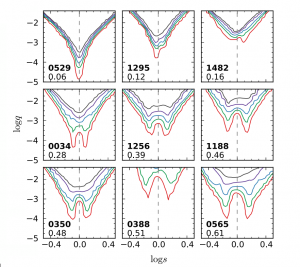Editor’s note: Astrobites is a graduate-student-run organization that digests astrophysical literature for undergraduate students. As part of the partnership between the AAS and astrobites, we occasionally repost astrobites content here at AAS Nova. We hope you enjoy this post from astrobites; the original can be viewed at astrobites.org!
Title: Towards a Galactic Distribution of Planets. I: Methodology & Planet Sensitivities of the 2015 High-Cadence Spitzer Microlens Sample
Authors: Wei Zhu, A. Udalski, S. Calchi Novati et al.
First Author’s Institution: Ohio State University
Status: Published in AJ
I don’t know if you’ve heard, but astronomers have found quite a few exoplanets in the last couple of decades. However, most of these are clustered in our tiny corner of the galaxy. For the 2,043 planets with stellar distance listed on exoplanets.org today (yes, I know this article will be out of date in a week…) the average distance from to the host star from Earth is 624 pc. The center of the galaxy, meanwhile, is ~8,000 pc away. That’s further than even the furthest known exoplanet, OGLE-05-390L b, which is 6,500 pc from us.
And we’d really like to have a better understanding of the exoplanets in the galactic bulge, because their presence — or lack thereof — helps us to understand planet formation. Planet formation is believed to be affected by several external factors such as the host star’s metallicity, the stellar mass, the stellar multiplicity, and the stellar environment. That final category is what we’re going to consider today: does the presence of a large number of nearby stars interrupt the formation of planets? The galactic bulge, as the part of the galaxy with the highest number density of stars, is an ideal place to test this — if only we could detect enough planets out there…

OGLE telescope at the Las Campanas Observatory in Chile. [Krzysztof Ulaczyk]
Unlike the radial-velocity, transit or direct-imaging methods for exoplanet hunting, the microlensing technique is able to detect exoplanets at huge distances. Meanwhile, a field with physically more stars is a great place for microlensing experiments, since a large number of stars need to be monitored for a long time so as to catch some of these chance alignments of foreground and background stars. As such, OGLE has been staring at the center of the galaxy for over a decade.
More recently, the microlensing community has become particularly interested in microlensing detections that have been measured by multiple different telescopes simultaneously. In a typical microlensing event, the mass and the distance of the foreground lensing star are degenerate. However, this degeneracy can be broken by comparing several simultaneous observations of the microlensing event with physically separated telescopes. The wider the separation between the different telescopes measuring the microlensing detection, the better — so why not use a telescope in space? The Spitzer telescope is almost 200,000,000 km away, giving an impressive distance baseline for this kind of work.

Figure 1: Sensitivities to planets for a subset of the survey. Red, green, blue, purple and black curves show the depth to which 15, 30, 45, 60 and 75% of planets could be detected; q and s represent the mass ratio and projected separation of the planets. The bottom left corner lists the OGLE catalog number (bold) and the impact parameter, which represents the closest on-sky separation of the two stars during the entire event. [Adapted from Zhu et al. 2017]
The authors model each of the lensing events with a variety of planets orbiting the nearby star, so as to determine how sensitive the survey is to exoplanets as a function of mass and separation. Some of these sensitivity curves are shown in Figure 2 above. The authors then carry out a statistical analysis; for this they use a simple parametrised model of the galaxy as a bulge and a disk, a couple of different assumptions about the stellar mass function, the footprint of the survey on the sky, some beastly Bayes calculations and information about their survey’s sensitivity to planets.
On the assumption that planetary frequency is the same in the galactic bulge, the authors find that roughly a third of all planetary detections in a survey like this one should come from bulge events. Since they have no planet detections in this sample, they aren’t yet able to calculate what fraction of detections actually come from the galactic bulge — this is left as future work. If the number turns out to be significantly different from the value of one third calculated here, it will reveal crucial information about planet formation in crowded regions of the galaxy. This work is currently ongoing. And, if they get lucky, maybe OGLE-05-390L b’s record as most-distant-planet will soon be broken!
About the author, Elisabeth Matthews:
I’m a third year PhD student at the University of Exeter, in the south of England, where I’m aiming to detect and characterise extrasolar planets and debris disks via direct imaging. So far this has meant lots of detecting background stars that happen to be well aligned with bright, nearby stars and no detecting of actual planets — but hopefully my luck will change soon!
